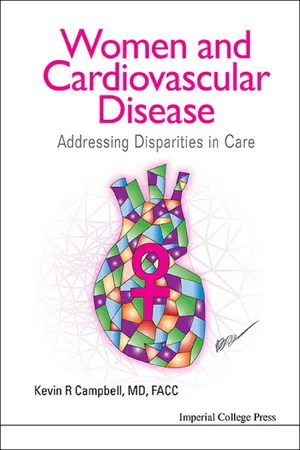
- 148 pages
- English
- ePUB (mobile friendly)
- Available on iOS & Android
About this book
Cardiovascular disease is the number one killer of both men and women in the US and Europe today. Over the last 20 years, many innovations in technology have allowed for improved therapies for heart attack and stroke and overall outcomes have significantly improved. Death rates from cardiovascular disease in men are declining.
However, even with these improvements in care, death rates for women remain unchanged. This book will explore these gender disparities in care in depth — specific sections will be devoted to answering the questions of why they are occurring and what healthcare providers and women can do to effect change and narrow the gender gap in cardiovascular care.
Ultimately, this book is designed to open the eyes of healthcare providers, medical professionals and policy makers — as well as potential female patients — and should serve as a "call to action" to promote better cardiovascular care for women. Through education, awareness and advocacy women worldwide will benefit, the gap will begin to close and better cardiovascular care can be provided for all.
Contents:
- Dedication
- About the Artist
- About the Author
- Introduction
- Epidemiologic Considerations in Cardiovascular Disease
- Gender Differences in Disease Manifestation and Presentation
- Gender Differences in Testing and Evaluation
- Gender Differences in the Treatment of Coronary Artery Disease
- Exploring the Root Causes
- Closing the Gap: Strategies to Effect Change
- The Role of the OB/GYN in Improving Women's Cardiovascular Health
- Taking Control: Battling Obesity through Exercise
- Taking Control: Battling Obesity through Dietary Change and Stress Management
- Special Considerations: Women and Sudden Cardiac Death
- Women and Congestive Heart Failure
- Empowering Women to Take Control
- Women and Atrial Fibrillation
- Index
Readership: General readers, women interested in empowering their health, healthcare professionals, healthcare managers, and healthcare policymakers. Key Features:
- No other book specifically addresses gender disparity in cardiovascular disease
- As a champion and advocate for women with cardiovascular disease over the last ten years, Campbell is uniquely positioned as an expert in this arena
- Author uses "real world" examples to provide insight for healthcare providers and patients
Frequently asked questions
- Essential is ideal for learners and professionals who enjoy exploring a wide range of subjects. Access the Essential Library with 800,000+ trusted titles and best-sellers across business, personal growth, and the humanities. Includes unlimited reading time and Standard Read Aloud voice.
- Complete: Perfect for advanced learners and researchers needing full, unrestricted access. Unlock 1.4M+ books across hundreds of subjects, including academic and specialized titles. The Complete Plan also includes advanced features like Premium Read Aloud and Research Assistant.
Please note we cannot support devices running on iOS 13 and Android 7 or earlier. Learn more about using the app.
Information
Table of contents
- Cover
- Half Title
- Title Page
- Copyright
- Dedication
- About the Artist
- About the Author
- Contents
- Introduction
- Chapter One. Epidemiologic Considerations in Cardiovascular Disease
- Chapter Two. Gender Differences in Disease Manifestation and Presentation
- Chapter Three. Gender Differences in Testing and Evaluation
- Chapter Four. Gender Differences in the Treatment of Coronary Artery Disease
- Chapter Five. Exploring the Root Causes
- Chapter Six. Closing the Gap: Strategies to Effect Change
- Chapter Seven. The Role of the OB/GYN in Improving Women’s Cardiovascular Health
- Chapter Eight. Taking Control: Battling Obesity through Exercise
- Chapter Nine. Taking Control: Battling Obesity through Dietary Change and Stress Management
- Chapter Ten. Special Considerations: Women and Sudden Cardiac Death
- Chapter Eleven. Women and Congestive Heart Failure
- Chapter Twelve. Empowering Women to Take Control
- Chapter Thirteen. Women and Atrial Fibrillation
- Index